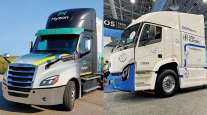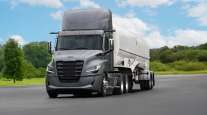Senior Reporter
Daimler Fuel Cell Truck Completes Long-Distance Run

[Stay on top of transportation news: Get TTNews in your inbox.]
BERLIN — Daimler Truck demonstrated the potential for a fuel cell-powered truck by completing an approximately 650-mile run with its Mercedes-Benz GenH2 cabover model along roads in its native Germany.
Officials touted the trip as proof that heavy cargo can be transported across long distances with zero tailpipe emissions.
On a single hydrogen fueling, the 88,000-pound truck-and-trailer combination covered 1,047 kilometers during an overnight run along the autobahn. A driver team departed from the company’s 10 million square-foot plant in the city of Wörth am Rhein, and arrived Sept. 26 in Germany’s capital.
Before departure, the truck was fueled with nearly 180 pounds of hydrogen. Officials with certification agency TUV Rhineland placed seals on both of the truck’s 90-gallon tanks to verify no refueling would take place en route. The trailer was hauling 55,000 pounds of gravel.
Hundreds of invited guests and dozens of international press were on hand for the truck’s arrival, while drones transmitted real-time video to huge screens installed at the trip’s destination point. The truck wound its way through Berlin’s boulevards and along Ebertstrabe Street before arriving at a plaza a short distance from the city’s historic Potsdam Plaza and Brandenburg Gate.

Gorbach by Dan Ronan/Transport Topics
“This was a goose bumps moment,” Daimler Truck head of technology Andreas Gorbach told Transport Topics. “It was a once-in-a-lifetime moment. Many people and [much] effort have gone into this hydrogen research the last several years.”
Gorbach, who drove the truck for the final segment, serves as a leading researcher in the company’s fuel cell efforts. He was joined at a Sept. 26 media event to commemorate the run by Cellcentric CEO Dr. Matthias Jurytko. Cellcentric is a joint venture formed in 2021 between Daimler and Volvo Trucks to develop hydrogen fuel cell technology that both plan to use in their respective vehicle lineups.
Jurytko stressed that the demonstration set up future testing and eventual commercial manufacturing for hydrogen fuel cell trucks, perhaps as soon as the end of this decade. He noted that progressively tougher European Union emission requirements taking effect over the next 25 years are propelling developing of zero-emission technologies.
While he acknowledged that the initial cost of these trucks will be higher than their diesel counterparts, he said economies of scale should drive down prices as more are built. Plus, he said fees that may someday be charged for carbon emissions could factor into the equation.

Jurytko stands with the 3-foot tall fuel cell that produces high voltage electricity when pressurized, and super cooled hydrogen is mixed with oxygen. The electricity then goes to an electric axle which drives the truck. (Dan Ronan/Transport Topics)
“You have to look at the total cost of ownership over five years,” Jurytko said. “Eventually, you’re going to have to pay for the CO2 of the fossil fuels in a tax, and the diesel cost will be so much higher than a CO2-neutral transportation fuel such as hydrogen. That is what will make them viable as a total cost of ownership, This is a business case.”
The two tanks hold pressurized, supercooled liquid hydrogen, which then goes into the fuel cell. From there, it mixes with oxygen to create a chemical reaction that produces electricity that is transported by cable to an electric axle, which powers the truck. The trucks emit only a cloud of water vapor from its exhaust, and its operation is much quieter than a diesel truck.
We’ve made it! After more than 1,000 km, our #MercedesBenz #GenH2 Truck has successfully completed its record run – on a single fill of liquid hydrogen! #HydrogenRecordRun🚛🏅#MovingForward #FuelCellTruck #HydrogenTruck #FuelCell #Sustainability #FutureMoves pic.twitter.com/BYQMNYIa6k — Daimler Truck AG (@DaimlerTruck) September 26, 2023
Caroline Stancell, Daimler’s European general manager of hydrogen mobility for air products, said this setup addresses range-anxiety concerns some customers have. Now, she said, its up to governments and the private sector to build hydrogen-fueling infrastructure. Daimler’s plan is to ramp up manufacturing while government and the private sector work on regulatory frameworks and fueling networks.
“This is very significant,” she said. “This truck has the range that we all want — this is a fundamental step [for] change,” she said. “A company with the financial resources and stability like Daimler [has] the economic power to bring a large number of these trucks to the market in 2027, 2028 and beyond.”

The back of the Daimler GenH2 truck showed the route it was taking, from Wörth am Rhein to Berlin. (Dan Ronan/Transport Topics)
Stancell and others stressed that for hydrogen-powered vehicles to be considered carbon neutral, they must be fueled with so-called green hydrogen that is produced with renewable energy such as wind or solar power. Daimler said the liquid hydrogen setup can be refueled in about 20 minutes, comparable with today’s diesels.
Daimler has committed to the Paris Climate Agreement, and said it will have CO2-neutral vehicles in operation in its global core markets, including the U.S., Europe and Japan, by 2039. It said the GenH2 was an important step forward.
“This is a call to action for all the players involved to pull together — especially on the infrastructure side,” Gorbach said. “The number of trucks on the road is a mirror image of how well the economy is doing. As we decarbonize, we need to find substitutions for diesel while we still grow. For longhaul transportation, hydrogen is a better choice for most customers.”
Want more news? Listen to today's daily briefing below or go here for more info:




